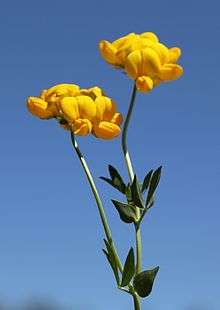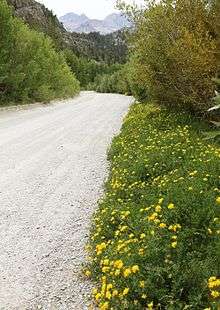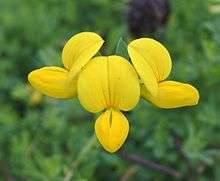Lotus corniculatus
| Lotus corniculatus | |
|---|---|
| | |
| Scientific classification | |
| Kingdom: | Plantae |
| (unranked): | Angiosperms |
| (unranked): | Eudicots |
| (unranked): | Rosids |
| Order: | Fabales |
| Family: | Fabaceae |
| Subfamily: | Faboideae |
| Tribe: | Loteae |
| Genus: | Lotus |
| Species: | L. corniculatus |
| Binomial name | |
| Lotus corniculatus L. | |
| Synonyms[1] | |
|
List
| |



Lotus corniculatus is a common flowering plant in the pea family Fabaceae, native to grassland in temperate Eurasia and North Africa. Common names include common bird's-foot trefoil[2] and just bird's-foot trefoil,[3] though the common name is often also applied to other members of the genus. It is also known in cultivation in North America as bird's-foot deervetch.
It is a perennial herbaceous plant, similar in appearance to some clovers. The flowers are mostly visited by bumblebees[4] and develop into small pea-like pods or legumes. The name 'bird's foot' refers to the appearance of the seed pods on their stalk. Five leaflets are present, but with the central three held conspicuously above the others, hence the use of the name 'trefoil'. It is often used as forage and is widely used as food for livestock due to its nonbloating properties.
Description
The height of the plant is variable, from 5–20 cm, occasionally more where supported by other plants; the stems can reach up to 50 cm long. It is typically sprawling at the height of the surrounding grassland. It can survive fairly close grazing, trampling, and mowing. It is most often found in sandy soils. It flowers from June to September.
The plant has had many common English names in Britain, which are now mostly out of use. These names were often connected with the yellow and orange colour of the flowers, e.g. 'butter and eggs'. One name that is still used is eggs and bacon (or bacon and eggs).[5]

Habitat
Old fields and grassy places[6] and roadsides.[7]
Distribution
Common everywhere in Britain.[8] Abundant in Ireland,[9] including Counties Londonderry, Down and Antrim.[7]
Uses
It is used in agriculture as a forage plant, grown for pasture, hay, and silage. It is a high quality forage that does not cause bloat in ruminants. [10] Taller-growing cultivars have been developed for this. It may be used as an alternative to alfalfa in poor soils. It has become an invasive species in some regions of North America and Australia.
A double-flowered variety is grown as an ornamental plant. The plant is an important nectar source for many insects and is also used as a larval food plant by many species of Lepidoptera such as six-spot burnet. It is regularly included as a component of wildflower mixes in Europe. It can also prevent soil erosion and provide a good habitat for wildlife.[10]
Fresh bird's-foot trefoil contains cyanogenic glycosides,[11] which release small amounts of hydrogen cyanide when macerated. This is not normally poisonous to humans, though, as the dose is very low, and the metabolization of cyanide is relatively quick.[12] Condensed tannins are also present in L. corniculatus, which has been known to increase the protein absorption of the small intestine.[13] Used in an infusion to avoid the creation of hydrogen cyanide, this plant can be used as a sedative [14]
References
- ↑ "The Plant List: A Working List of All Plant Species". Retrieved March 14, 2014.
- ↑ "BSBI List 2007". Botanical Society of Britain and Ireland. Archived from the original (xls) on 2015-01-25. Retrieved 2014-10-17.
- ↑ "Lotus corniculatus". Natural Resources Conservation Service PLANTS Database. USDA. Retrieved 23 June 2015.
- ↑ Van Der Kooi, C. J.; Pen, I.; Staal, M.; Stavenga, D. G.; Elzenga, J. T. M. (2015). "Competition for pollinators and intra-communal spectral dissimilarity of flowers" (PDF). Plant Biology. 18: 56. doi:10.1111/plb.12328.
- ↑ Collins English Dictionary
- ↑ Clapham, A.R., Tutin, T.G. and Warburg, E.F. 1968. Excursion Flora of the British Isles, Cambridge University Press. ISBN 0-521-04656-4
- 1 2 Hackney, P. (Ed) 1992. Stewart & Corry's Flora of the North-east of Ireland, Third Edition. Institute of Irish Studies,The Queen's University of Belfast. ISBN 0-85389-446-9
- ↑ Martin, K. The Concise British Flora in Colour.
- ↑ Parnell, J. and Curtis, T. 2012. Webb's An Irish Flora. Cork University Press ISBN 978-185918-4783
- 1 2 Heuzé V., Tran G., Nozière P., Lebas F., 2016. Birdsfoot trefoil (Lotus corniculatus). Feedipedia, a programme by INRA, CIRAD, AFZ and FAO. http://www.feedipedia.org/node/280 Last updated on February 8, 2016, 13:52
- ↑ http://www.pfaf.org/database/plants.php?Lotus+corniculatus
- ↑ Scriber, J. Mark (1 January 1978). "Cyanogenic Glycosides in Lotus corniculatus. Their Effect upon Growth, Energy Budget, and Nitrogen Utilization of the Southern Armyworm, Spodoptera eridania". Oecologia. 34 (2): 143–155. JSTOR 4215630. doi:10.2307/4215630 (inactive 2017-01-30).
- ↑ http://www.grassland.org.nz/publications/nzgrassland_publication_492.pdf
- ↑ http://plantes-davenir.loncletom.fr/plants/lotus-corniculatus
External links
| Wikimedia Commons has media related to Lotus corniculatus. |
| Wikiversity has bloom time data for Lotus corniculatus on the Bloom Clock |
- Jones, D.A. and Turkington, R., 1986. Biological flora of the British Isles: Lotus corniculatus. Journal of Ecology 74, pp.1185-1212.
- Jepson manual Treatment
- USDA Plants Profile
- Photo gallery